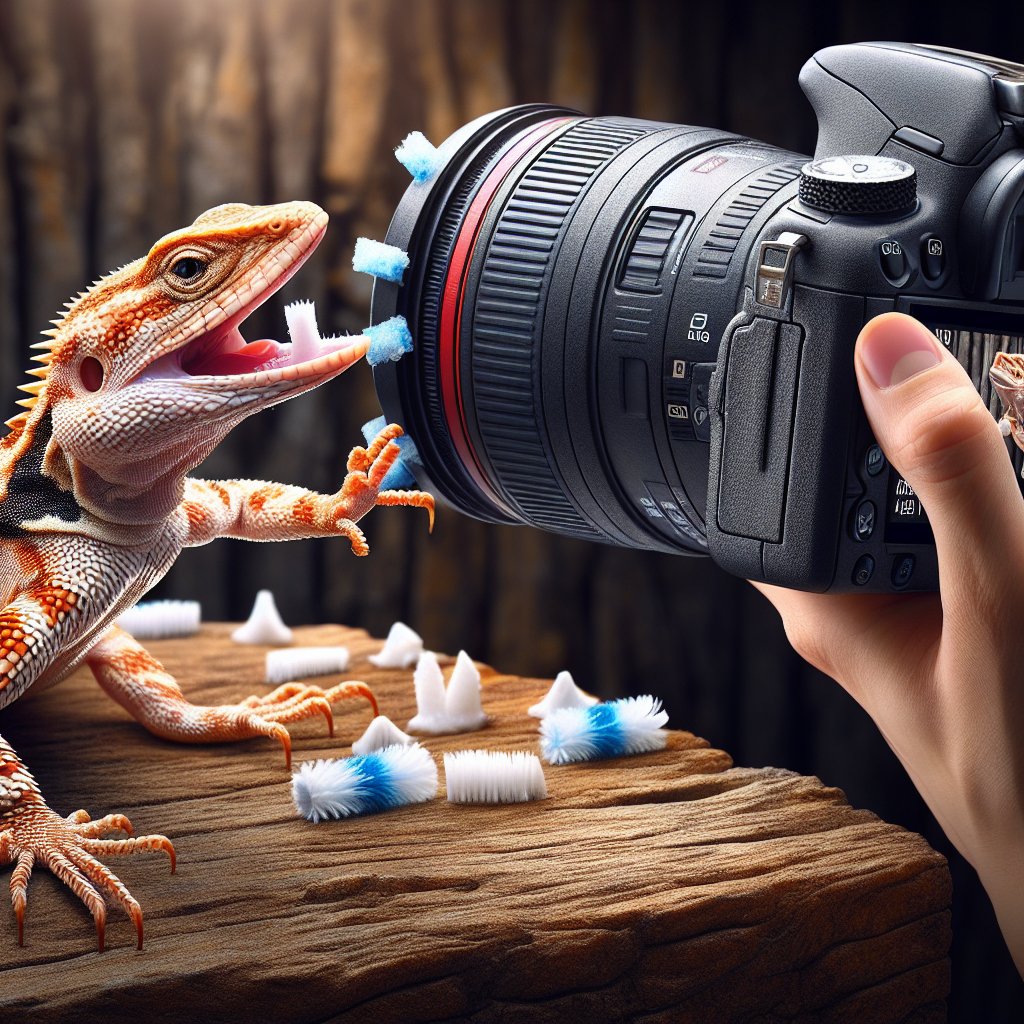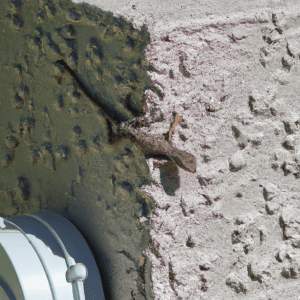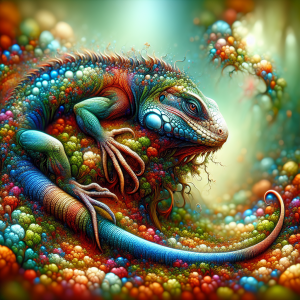Importance of Lizard Habitat Hygiene Practices
Have you ever thought about the cleanliness of your lizard’s habitat and how it impacts their health and well-being? It’s more crucial than you might think! Let me tell you about the importance of lizard habitat hygiene practices.
Imagine this – a few years back, a friend of mine neglected to clean her lizard’s enclosure regularly. She noticed her lizard becoming sluggish and developing skin issues. After consulting a vet, she realized that the unclean environment was the root cause of her lizard’s health problems. That incident made me realize the significance of maintaining a clean habitat for these fascinating creatures.
Did you know that maintaining proper hygiene in your lizard’s habitat is not just about aesthetics but also about their health? Lizards are sensitive creatures that can easily get stressed or fall ill if their living conditions are not clean and hygienic. By providing a clean environment, you are ensuring that your pet lizard stays healthy and happy.
One practical tip I can offer is to establish a regular cleaning routine for your lizard’s habitat. This includes removing waste, cleaning the enclosure, and sanitizing any accessories or decorations. By keeping the habitat clean, you are reducing the risk of bacterial growth and infections that can harm your lizard.
Think about it – would you want to live in a dirty and unhygienic environment? Of course not! Similarly, your pet lizard deserves a clean and healthy habitat to thrive in. By taking the time to maintain proper hygiene practices, you are not only ensuring your lizard’s well-being but also strengthening the bond between you and your scaly companion.
So, next time you look at your lizard’s habitat, remember the impact that cleanliness can have on their health and happiness. Implementing good hygiene practices is a simple yet effective way to show your pet lizard that you care for them in every aspect.
Understanding the Needs of Pet Lizards
Understanding the Needs of Pet Lizards is crucial when it comes to creating a suitable habitat for these fascinating creatures. Imagine you have a friend who is a picky eater – they have specific dietary requirements, need a comfortable living space, and enjoy certain activities. Well, pet lizards are no different! They have unique needs that must be met to ensure their well-being and happiness.
Just like us, lizards require a balanced diet, appropriate temperature, and adequate space to move around. However, they also have some peculiar preferences that we need to consider. For example, did you know that some lizards are arboreal, meaning they prefer to climb and perch on branches, while others are terrestrial and like to burrow in the substrate? Understanding these behaviors and habitats can help us create a more enriching environment for our scaly friends.
When setting up a habitat for your pet lizard, it’s essential to provide a variety of elements that mimic their natural surroundings. This could include rocks for basking, hiding spots for security, and different textures for them to explore. By catering to their specific needs, you can create a space where your lizard feels safe, comfortable, and stimulated.
Consider the broader implications of meeting your pet lizard’s needs. Just like any other pet, they rely on us to provide them with a suitable environment that promotes their physical and mental well-being. By understanding and fulfilling their requirements, we can ensure that our pet lizards lead happy and healthy lives. So, let’s dive into the world of pet lizards and learn more about the fascinating creatures we share our homes with!
Setting Up a Hygienic Habitat for Your Lizard
Setting up a hygienic habitat for your pet lizard is crucial for their health and well-being. When I first got my lizard, I had no idea how important it was to create a clean and safe environment for them. But after doing some research and learning the ropes, I realized just how essential it is to get things right from the start.
One interesting fact about creating a lizard habitat is that different species have varying requirements when it comes to their living space. For instance, some lizards need a lot of vertical space to climb and explore, while others may prefer a habitat with more ground space. Understanding your specific lizard’s needs is key to setting up a suitable and hygienic environment for them.
When it comes to setting up the habitat, there are a few key things to keep in mind. Firstly, make sure to choose the right substrate for the enclosure. The substrate should be easy to clean and maintain to prevent bacteria and mold buildup. Additionally, providing hiding spots and climbing structures will help mimic their natural habitat and keep them active and healthy.
Another essential aspect is maintaining proper temperature and humidity levels in the enclosure. Lizards are ectothermic, meaning they rely on external sources of heat to regulate their body temperature. Investing in a good quality heat lamp and thermometer will help you monitor and adjust these levels accordingly.
It’s also important to regularly clean and disinfect the habitat to prevent the growth of harmful bacteria and parasites. Cleaning the enclosure, removing waste, and replacing water and food regularly are all essential tasks to ensure a hygienic environment for your lizard.
By following these tips and setting up a clean and safe habitat for your pet lizard, you’ll be providing them with the best possible care and ensuring they lead a healthy and happy life.
Cleaning and Maintaining the Lizard Enclosure
Have you ever wondered how to keep your lizard’s enclosure squeaky clean and cozy? Let me fill you in on the secrets of maintaining a spotless habitat for your scaly friend.
Cleaning and maintaining the lizard enclosure is crucial for your pet’s health and well-being. Picture this: your lizard basking under a heat lamp, exploring its habitat, and enjoying a meal. With all that activity, the enclosure can quickly become a mess. That’s where regular cleaning comes into play.
One practical tip I swear by is to establish a cleaning routine that includes daily spot cleaning and weekly deep cleaning. By removing uneaten food, shedding, and waste promptly, you can prevent bacteria buildup and keep the habitat odor-free. Trust me; your nose will thank you!
When it comes to deep cleaning, it’s essential to use reptile-safe cleaning products and avoid harsh chemicals that can harm your lizard. A mixture of mild soap and water works like a charm for wiping down surfaces, while a vinegar solution can help disinfect the enclosure without leaving harmful residues.
Now, here’s a fun fact for you: did you know that some lizards are known to be meticulous groomers? While they may keep themselves clean to some extent, it’s still crucial for you to maintain a hygienic environment for their overall health.
So, grab your cleaning supplies, put on your favorite tunes, and make lizard habitat cleaning a breeze. Your scaly companion will appreciate the fresh environment, and you’ll have peace of mind knowing you’re providing the best care possible. Happy cleaning!
Proper Handling of Food and Water for Lizards
Imagine you’re setting up a new home for your pet lizard and you’re figuring out the best way to handle their food and water needs. It may seem simple, but there are some key points to keep in mind to ensure your lizard stays healthy and happy.
One practical tip to consider is the type of food and water containers you use for your lizard. Lizards can be messy eaters and drinkers, so choosing the right containers can help minimize spills and keep their habitat cleaner. Opt for shallow dishes for water to prevent accidental drowning and choose sturdy, easy-to-clean food bowls to avoid food residue buildup.
It’s fascinating to note that some lizards are picky eaters and may refuse to drink from still water sources. In such cases, providing moving water, like a gentle stream or a dripping system, can attract their attention and encourage them to stay hydrated. Observing your lizard’s behavior around food and water can provide valuable insights into their preferences and habits.
By monitoring and adjusting the placement of food and water containers, you can ensure that your lizard has easy access to essential nutrients and hydration. Remember to clean and refill these containers regularly to prevent the growth of harmful bacteria and maintain a hygienic habitat for your pet.
Understanding your lizard’s unique needs and behaviors when it comes to food and water can enhance your bond with your pet and contribute to their overall well-being. Experimenting with different feeding and watering techniques can be a fun way to engage with your lizard and create a stimulating environment for them to thrive.
Monitoring and Controlling Temperature and Humidity Levels
Have you ever wondered how crucial it is to maintain the right temperature and humidity levels for your pet lizard? Well, let me tell you, it’s a game-changer!
You see, just like us, lizards are quite particular about their living conditions. They need the perfect balance of warmth and moisture to thrive. If the temperature gets too high or too low, or if the humidity levels are off, your lizard could face serious health issues. It’s like trying to survive in a sauna or a freezer – not ideal, right?
Imagine this – you come home after a long day, and your lizard is looking a bit sluggish. You check the thermometer and realize the terrarium is too cold. That’s when you remember the importance of monitoring and controlling the temperature and humidity levels in your lizard’s habitat. It’s like being a weatherman for your scaly friend!
Did you know that some lizard species are more sensitive to temperature changes than others? For example, desert-dwelling lizards like bearded dragons require a basking spot with high heat, while tropical lizards like green anoles prefer a more moderate temperature range. Understanding your lizard’s specific needs is key to creating a comfortable environment for them.
So, the next time you’re setting up your lizard’s home, think about how you can create a cozy space that mimics their natural habitat. Invest in a quality thermometer and hygrometer to keep track of the conditions. And don’t forget to adjust the heating and lighting sources accordingly to ensure your scaly buddy stays happy and healthy.
By taking the time to monitor and control the temperature and humidity levels in your lizard’s habitat, you’re not just providing a comfortable home for your pet – you’re also promoting their overall well-being and longevity. It’s all about creating a warm and cozy paradise where your lizard can bask, explore, and thrive.
Preventing and Managing Common Health Issues in Lizards
Have you ever wondered how to keep your pet lizard healthy and happy? Let’s dive into preventing and managing common health issues in lizards. One interesting fact is that lizards are susceptible to various health problems if their habitat is not properly maintained. For instance, inadequate temperature levels can lead to respiratory issues, while poor hygiene may cause skin infections. It’s essential to be proactive in monitoring your lizard’s health to catch any signs of illness early on.
One practical tip is to create a routine for regular health checks. By observing your lizard’s behavior and appearance daily, you can quickly notice any changes that may indicate an underlying health issue. Look out for signs like lethargy, loss of appetite, or unusual bumps on the skin. If you notice anything concerning, don’t hesitate to consult a vet specializing in reptiles.
Another crucial aspect is understanding the specific health needs of your lizard species. Different types of lizards have varying requirements in terms of diet, temperature, and humidity levels. Researching and familiarizing yourself with the specific care guidelines for your pet lizard can help you provide the best possible environment for them.
When it comes to managing health issues, prevention is key. Regularly clean and disinfect your lizard’s enclosure to reduce the risk of bacterial or fungal infections. Ensure that the temperature and humidity levels are within the optimal range for your lizard’s species. Providing a balanced diet and proper hydration is also essential for their overall health and immunity.
By taking proactive measures and staying vigilant about your pet lizard’s health, you can create a safe and comfortable habitat for them to thrive. Remember, a healthy lizard is a happy lizard!
Tips for Regular Health Checks and Hygiene Routines
Have you ever tried giving your lizard a health check-up at home? It may sound a bit intimidating at first, but trust me, it’s not as tricky as it seems. When it comes to maintaining the hygiene and well-being of your pet lizard, regular health checks play a crucial role.
Let me share a personal anecdote with you. One day, I noticed that my lizard was acting a bit sluggish and not as active as usual. Concerned about his health, I decided to give him a thorough check-up. By examining his skin, eyes, and behavior closely, I was able to identify a minor issue early on and take the necessary steps to address it promptly.
Performing regular health checks on your lizard not only helps you monitor their overall well-being but also allows you to detect any potential health problems early. Keep an eye out for signs of dehydration, skin abnormalities, changes in appetite, or unusual behavior. By being proactive and observant, you can prevent minor issues from escalating into more serious health concerns.
Remember, your lizard’s health is in your hands, quite literally! Taking the time to conduct routine health checks can make a significant difference in maintaining a healthy and happy pet. Plus, it’s a great way to bond with your scaly friend and show them some extra love and care.
So, the next time you’re spending quality time with your lizard, why not incorporate a quick health check into your routine? It’s a simple yet effective way to ensure that your pet is thriving in a clean and hygienic environment. After all, a healthy lizard is a happy lizard!
Importance of Proper Waste Management in the Lizard Habitat
Have you ever thought about the impact of waste management in a lizard habitat? It’s not the most glamorous topic, but it plays a crucial role in maintaining a healthy environment for your scaly friend. Let me share a little story to illustrate why proper waste management is so important.
Picture this: you’re enjoying a quiet evening at home when suddenly, a funky smell wafts into the room. You follow your nose to your lizard’s enclosure and discover a mess that would put a frat house to shame. Not only is it unsightly, but it’s also a breeding ground for bacteria and potential health hazards for your pet.
Proper waste management is more than just keeping things tidy; it’s about creating a safe and hygienic space for your lizard to thrive. By regularly removing feces, uneaten food, and soiled bedding, you can prevent the buildup of harmful bacteria and parasites that could make your lizard sick.
But here’s the kicker – waste management isn’t just about cleaning up after your lizard. It’s also an opportunity to monitor your pet’s health. Changes in waste consistency, color, or frequency can be early indicators of underlying health issues. By keeping a close eye on your lizard’s bathroom habits, you can catch potential problems early and take action to keep them healthy.
So, the next time you’re tempted to procrastinate on cleaning your lizard’s habitat, remember that proper waste management is about more than just aesthetics. It’s a vital part of responsible pet ownership and a key aspect of ensuring your lizard’s well-being. After all, a clean habitat is a happy habitat for your scaly companion.
Ensuring a Healthy and Happy Environment for Your Pet Lizard
Imagine you’re explaining the importance of proper waste management in the lizard habitat to a friend. Here’s a lively, informal yet informative conversation:
You know, one of the critical aspects of keeping your lizard healthy and happy is managing their waste effectively. It might not be the most glamorous topic, but trust me, it’s super important. Let me tell you about it.
So, picture this: a few months back, when I first got my lizard, I didn’t pay much attention to cleaning up its waste promptly. I thought, “It’s just a small mess, no big deal.” But oh boy, was I wrong! Not only did it start to smell pretty funky, but I also noticed my lizard was getting a bit stressed out. That’s when I realized the significance of proper waste management in their habitat.
It’s fascinating to note that lizards are quite sensitive creatures when it comes to their environment. Even a small buildup of waste can lead to health issues like bacterial infections or parasites. By maintaining a clean and hygienic habitat, you’re not only ensuring your lizard stays healthy but also creating a comfortable living space for them.
Now, here’s a practical tip for you: make it a routine to spot-clean your lizard’s enclosure every day. Remove any feces, uneaten food, or soiled substrate promptly to prevent the spread of bacteria. Trust me; your lizard will thank you for it!
Have you ever faced any challenges when it comes to managing waste in your lizard’s habitat? It can be tricky at times, but with a bit of consistency and effort, you’ll get the hang of it. Plus, it’s all part of being a responsible reptile owner, right?
So, next time you clean your lizard’s enclosure, remember the importance of proper waste management. It’s not just about keeping things tidy; it’s about creating a safe and healthy space for your scaly friend to thrive in.




